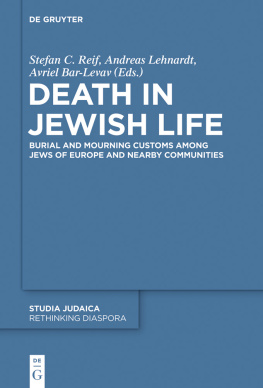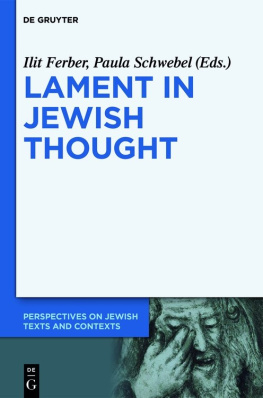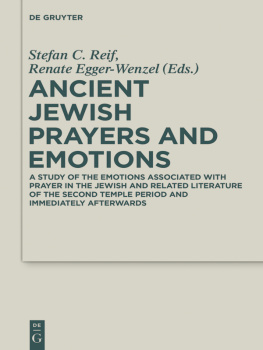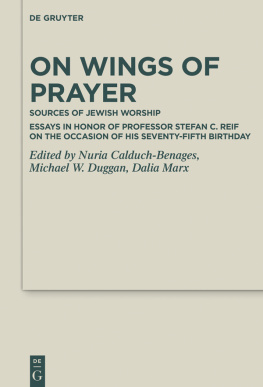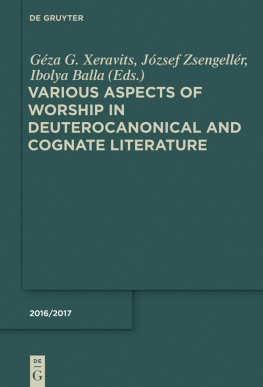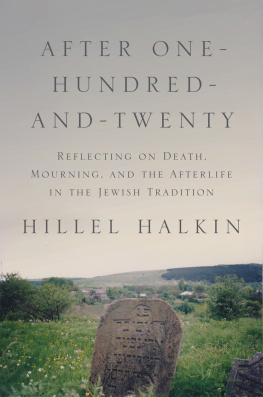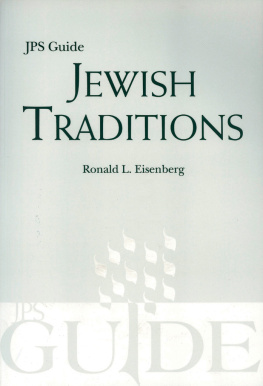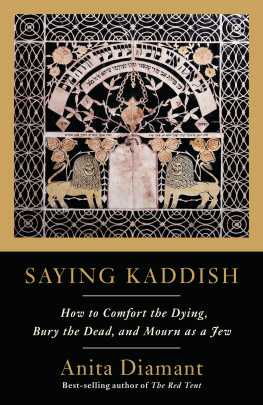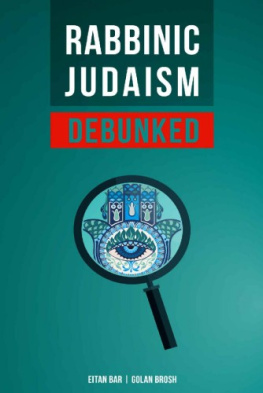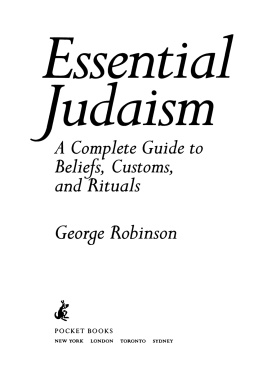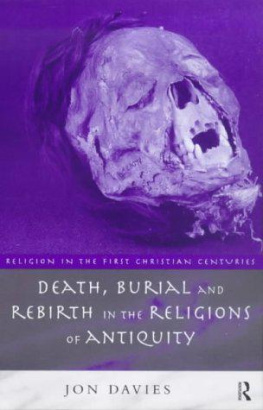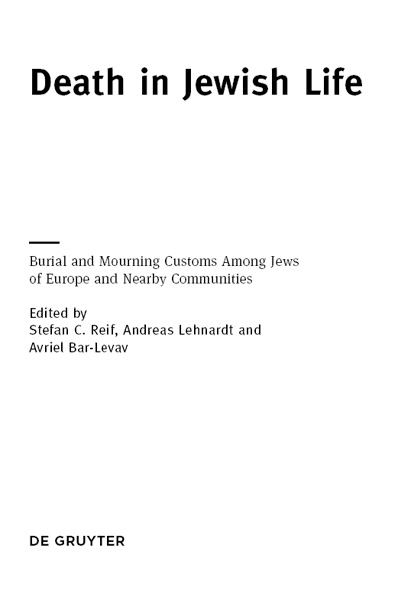The need to enhance the study of Jewish attitudes towards death in their broadest aspects was recognized and discussed in 2007 by Simha Goldin and Stefan Reif. They decided to organize a conference, and set up an international steering committee composed of Andreas Lehnardt, Avriel Bar-Levav and Uri Ehrlich, as well as themselves, chaired by Stefan Reif.
The conference was held at the Cymbalista Jewish Heritage Center and the Lester and Sally Entin Faculty of Humanities of Tel Aviv University on 1012 May 2010, with the aid of the Johannes Gutenberg University, Mainz, and under the auspices of the Goldstein-Goren Diaspora Research Center at Tel Aviv University. A total of twenty-two papers were delivered, in English and in Hebrew, the latter in the context of a Workshop devoted to Reading Gravestones as Texts, directed by Avriel Bar-Levav. The present volume represents the outcome of that conference, with some minor omissions and significant additions.
Frederick Paxton, whose keynote address provided the necessary background in the medieval Christian world for the whole topic of the conference, was also kind enough to respond favourably to the editors request to append to his paper some comments on the texts of all the other presentations that are included here. This was greatly appreciated.
The editors wish to thank all those individuals and institutions who contributed to the success of the conference and the preparation of the volume, especially Sara Appel, Ora Azta and other staff at the Goldstein-Goren Diaspora Research Center. They are also grateful to Dvora Bregman and Menahem Schmelzer for reviewing the manuscript and to the Johannes Gutenberg University, Mainz, and to the Harry and Gertrude Landy Charitable Trust for their support. They would also like to express their thanks to Albrecht Dhnert for establishing the Rethinking Diaspora Sub-Series at De Gruyter Publishing House, and to the editors of the Studia Judaica Series Charlotte Fonrobert, Alexander Samely, and Gnther Stemberger for kindly accepting the volume as the first in the new Sub-Series.
List of Acknowledgements
1. To the Jewish Theological Seminary in New York for permission to reproduce figures 1 and 9 in the article by Mauro Perani.
2. To the work Eletta dei monumenti pi illustri e classici , published in Bologna in 1840, volume II, for figure 20 in the article by Mauro Perani.
3. To Brooklyn Museum, Gift of the Ernest Erickson Foundation, Inc., for permission to reproduce figure 6 in the article by Minna Rozen.
4. To Christies Inc for permission to reproduce figure 9 in the article by Minna Rozen.
5. To the William Gross Collection, Tel Aviv, for permission to reproduce figure 16 in the article by Minna Rozen.
6. To the Walters Art Museum, Baltimore, for permission to reproduce figure 17 in the article by Minna Rozen.
7. To the Beinecke Rare Book and Manuscript Library, Yale University, for permission to reproduce figure 18 in the article by Minna Rozen.
8. To Professor Yaakov Bentolila and Professor Dvora Bregman for their kind assistance with the preparation of the article by Mauro Perani.
The rights to all the other figures reproduced in the volume belong to the authors of the articles in which they appear.
Details of the Contributors, with Summaries of their Essays
Avriel Bar-Levav is Senior Lecturer in Judaic Studies in the Department of History, Philosophy and Judaic Studies at the Open University of Israel, and editor of Peamim: Studies in Oriental Jewry , published by the Ben-Zvi Institute, Jerusalem, Israel.
Bar-Levav offers a framework for depicting and understanding the varied Jewish attitudes towards death, particularly in the medieval period. The author differentiates between death as an idea and death as a reality, and between the presence and absence of death. He suggests that, by and large, death is marginal in the framework of Jewish culture. Jewish attitudes towards death can be anchored between time, space and texts. There is a time of mourning and remembrance, there is a place for the dead (the cemetery), and there are distinct texts that are used in the contexts of dying and mourning. The paper describes various axes along which ideas about death may be perceived: death as punishment or desideratum; the amalgamation of the personality during life and its disintegration in death; the relationship between this world and the world to come; the connection of the soul and the body; and the burial society as a social and religious organization. Death offers a moral perspective on life, and this is also connected with the comprehension of dying as a life passage, and with the construction of the idea of the proper death.
Frederick S. Paxton is the Brigida Pacchiani Ardenghi Professor of History at Connecticut College, in New London, Connecticut, U.S.A.
Paxtons paper attempts to gather together the myriad social and religious behaviours around death, dying and commemoration of the dead in the Latin Christian Middle Ages within a common conceptual framework: the medieval economy of salvation. He argues that the medieval economy of salvation grew out of the patristic notion of the divine economy, whereby Gods gift of his sons life opened up a path to eternal salvation for humankind, to eventually encompass the transfer of people, goods, lands and incomes from private hands to religious communities in exchange for masses, psalms, prayers and alms for the poor, which were then offered to God in return for the salvation of the souls of the donors and their families. Paxtons particular focus is on the early growth of the economy of salvation, which culminated in the extraordinary success of the Benedictine Abbey of Cluny in the eleventh century and twelfth centuries.
Stefan C. Reif is Emeritus Professor of Medieval Hebrew Studies and Fellow of St Johns College at the University of Cambridge, U.K.
Reif began his response to Paxtons keynote address by stressing the need for Jewish scholars clinically to investigate the reasons, both theological and more general, for the revolutionary developments in death liturgy, especially among the Ashkenazi communities of the high Middle Ages. He stressed the major contribution made by pre-medieval and medieval Jewish teachers to liturgical development, how closely related Jewish trends were to their Christian counterparts, and the link made in the rabbinic sources, especially in liturgical custom, between prayers for the dead and charitable gifts. Reif also pointed to the tensions between halakhists and philosophers on one side of the religious spectrum and mystics on the other with regard to customs appertaining to burial and cemeteries. His concluding remarks drew parallels between Christian and Jewish periods of mourning, trends towards standardization and the composition of special benedictions for those who performed special communal tasks.

